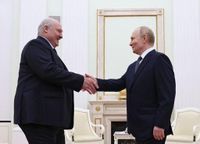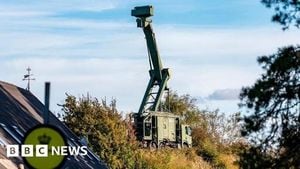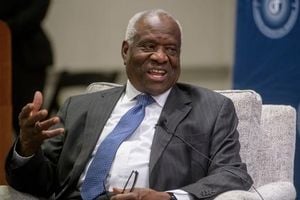On September 26, 2025, Belarusian President Alexander Lukashenko unveiled a proposal that has quickly reverberated across Eastern Europe and beyond: the construction of a new nuclear power plant in Belarus, designed specifically to supply electricity to Russian-occupied territories in Ukraine. The announcement, made during a high-profile meeting with Russian President Vladimir Putin in Moscow, has thrown a spotlight on the intricate ties between Minsk and Moscow and raised fresh questions about the region’s energy security, sovereignty, and the enduring complexities of post-invasion geopolitics.
According to Reuters, Lukashenko’s offer was direct: "If a decision is made, we will immediately begin building a new power unit or a new station if there is a need for electricity in western Russia and in the liberated regions." The term "liberated regions," used by both Lukashenko and Putin, refers to Ukrainian territories currently under Russian occupation—a linguistic choice that itself is loaded with political implications. The Belarusian leader emphasized the urgency of the project, signaling that construction could commence without delay should the green light be given.
Putin, for his part, appeared unfazed by the potential scale or expense of the undertaking. "Financing is not an issue at all. If there is a consumer who will take electricity and pay the required tariff, it's not a problem at all," he responded, as reported by Kyiv Independent. This matter-of-fact assurance underscored Russia’s willingness to back the project, provided there is stable demand and a willingness to pay—an arrangement that, on the surface, seems to sidestep the thornier questions of legality and international oversight.
The specifics of the plant’s location remain under consideration. Belarusian state media have reported that discussions are ongoing, with two main options on the table: expanding the current nuclear facility in Ostrovets by adding a third unit, or constructing an entirely new plant in the east of Belarus. "Personally, I have some doubts about where to build it. Either a third unit at the current station in Ostrovets, or to place it in the east. We can build in both places. I think we will decide soon," Lukashenko noted, according to Kyiv Independent. That flexibility reflects both the scale of Belarus’s nuclear ambitions and the strategic importance of proximity to the Russian-occupied regions.
Belarus’s support for Russia’s military actions in Ukraine is well documented. At the outset of the full-scale invasion in 2022, Belarus allowed its territory to be used as a staging ground for Russian troops attempting to seize Kyiv from the south, as detailed by Reuters. Although Belarus has not directly participated in combat operations, its logistical and political backing has been a consistent feature of the war.
The nuclear proposal, however, marks a new phase in Belarus’s involvement. By offering to supply energy directly to the occupied territories, Belarus is moving beyond passive support to a more active role in sustaining Russia’s hold on these regions. This has not gone unnoticed by Ukraine or the international community. Experts cited by Suspilne and other outlets warn that such a move raises significant concerns about regional energy security, the sovereignty of Ukraine, and adherence to international norms governing nuclear infrastructure and cross-border electricity supply.
Ukraine, for its part, sees the plan as yet another affront to its territorial integrity. The idea that a neighboring country would build a nuclear facility specifically to serve regions under foreign occupation is, understandably, deeply provocative. As reported by Suspilne, Ukrainian officials have interpreted the proposal as a signal of Belarus’s continued disregard for Ukraine’s sovereignty and a further entrenchment of Russia’s influence in the region.
From a technical perspective, the project appears feasible. Russia’s state nuclear corporation, Rosatom, is already a key player in the region’s nuclear sector and would likely oversee development, as noted by Reuters. Both Lukashenko and Putin have insisted that financial and logistical hurdles are surmountable, provided there is a clear consumer base and contractual certainty. "If there is a consumer who will use electricity and pay the necessary tariff, this is not a problem at all," Putin reiterated, according to Reuters.
Yet, the challenges extend far beyond engineering and finance. The proposal has reignited debates about the intersection of energy policy and geopolitics in Eastern Europe—a region where the flow of electricity is often entangled with the exercise of power and the assertion of national interests. As Reuters and Kyiv Independent both highlight, decisions about where and how to build nuclear plants cannot be separated from questions of legal status, international oversight, and the potential for escalation in an already volatile environment.
The timing of the proposal is also noteworthy. Despite ongoing Western efforts to isolate Belarus—efforts that have included offers of sanctions relief in exchange for political concessions, as reported by Ukrainska Pravda—Lukashenko has remained firmly in Moscow’s orbit. In fact, Putin reportedly meets with Lukashenko more frequently than with any other foreign leader, a testament to the depth of their alliance. The nuclear plan thus serves as both a practical and symbolic gesture, reinforcing the partnership between the two leaders even as it challenges Western attempts to draw Belarus closer to Europe.
For the people living in the affected regions—whether in Belarus, Russia, or occupied Ukraine—the implications are profound. Nuclear energy promises stable electricity, but it also brings with it concerns about safety, environmental impact, and the risk of accidents or sabotage in a conflict zone. International experts have stressed the need for clear legal frameworks, robust safety protocols, and strict adherence to international standards if the project moves forward. Anything less, they warn, could imperil not only local communities but also the broader stability of Europe’s energy market.
The broader context is hard to ignore. As the war in Ukraine grinds on, control over critical infrastructure—power plants, pipelines, and transmission lines—has become a key battleground. The Belarusian proposal is just the latest example of how energy policy and military strategy are increasingly intertwined, with each new development carrying the potential to reshape alliances, provoke retaliation, or trigger unintended consequences.
For now, the fate of the Belarusian nuclear project remains undecided. Lukashenko and Putin have signaled their readiness to proceed, but the final decision will depend on a host of factors: technical feasibility, political calculations, and the evolving dynamics of the war in Ukraine. What is clear, however, is that the proposal has already altered the regional landscape—raising the stakes for all parties and reminding the world that, in Eastern Europe, even the flow of electricity is a matter of high geopolitics.
As regional leaders weigh their next moves, the world will be watching closely. The outcome of this proposal could shape not only the fate of Ukraine’s occupied territories but also the future of energy security and sovereignty across the continent.





